winter tires TOYOTA RAV4 2020 Warranties & Maintenance Guides (in English)
[x] Cancel search | Manufacturer: TOYOTA, Model Year: 2020, Model line: RAV4, Model: TOYOTA RAV4 2020Pages: 260, PDF Size: 8.54 MB
Page 169 of 260
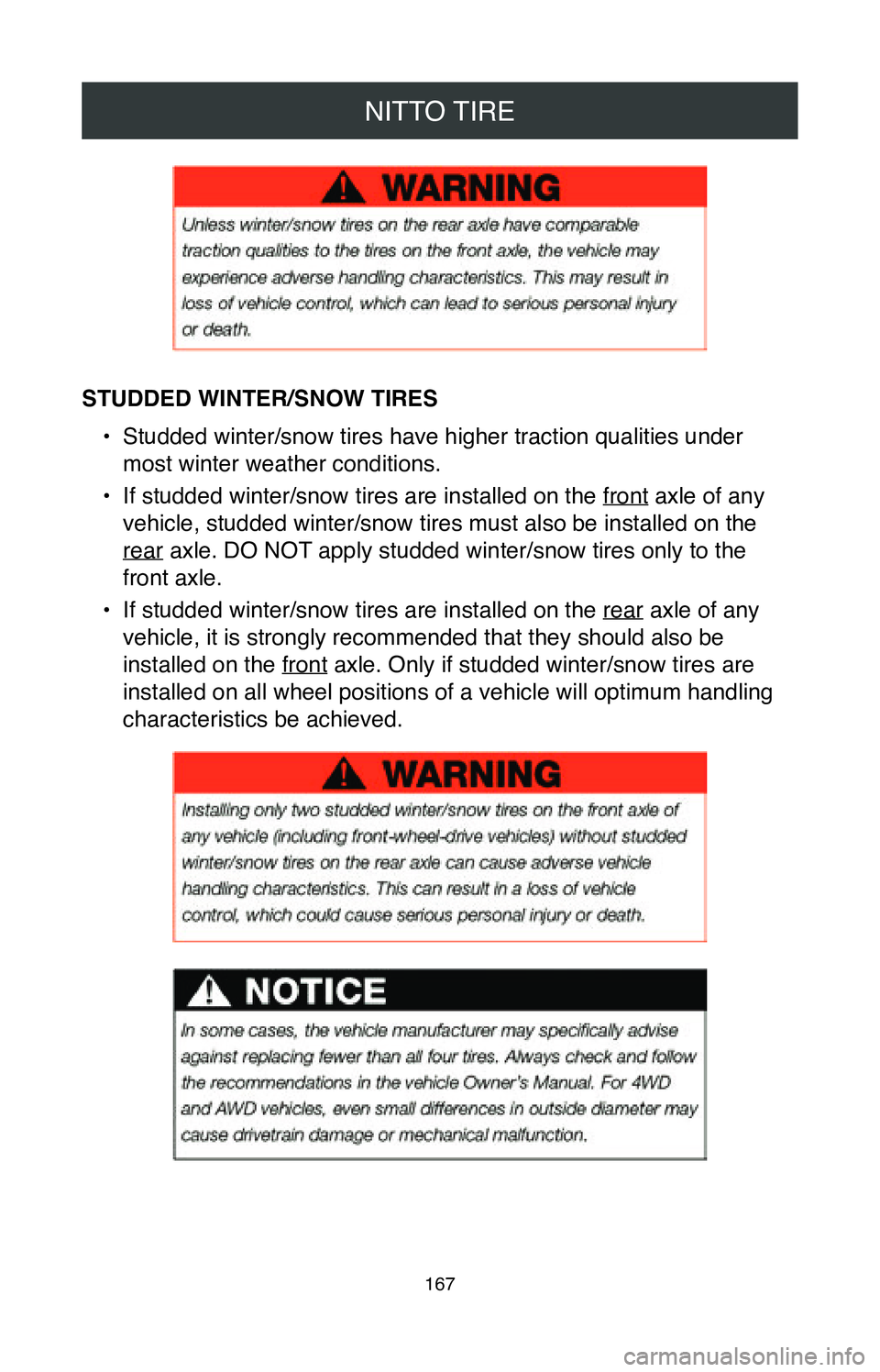
NITTO TIRE
167
STUDDED WINTER/SNOW TIRES•
Studded winter/snow tires have higher traction qualities under
most winter weather conditions.
•
If studded winter/snow tires are installed on the front axle of any
vehicle, studded winter/snow tires must also be installed on the
rear axle. DO NOT apply studded winter/snow tires only to the
front axle.
•
If studded winter/snow tires are installed on the rear axle of any
vehicle, it is strongly recommended that they should also be
installed on the front axle. Only if studded winter/snow tires are
installed on all wheel positions of a vehicle will optimum handling
characteristics be achieved.
Page 177 of 260
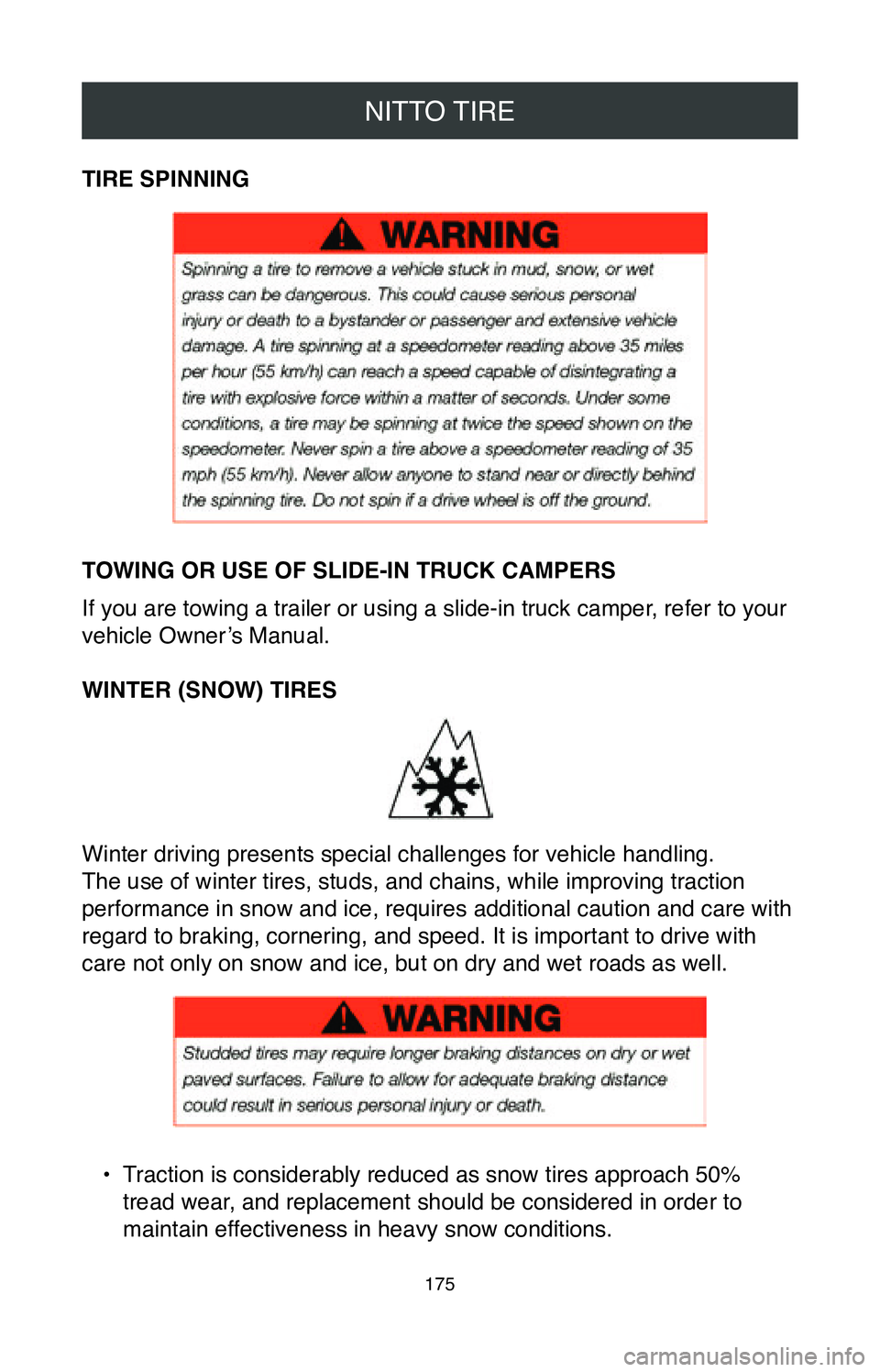
NITTO TIRE
175
TIRE SPINNING
TOWING OR USE OF SLIDE-IN TRUCK CAMPERS
If you are towing a trailer or using a slide-in truck camper, refer to your
vehicle Owner’s Manual.
WINTER (SNOW) TIRES
Winter driving presents special challenges for vehicle handling.
The use of winter tires, studs, and chains, while improving traction
performance in snow and ice, requires additional caution and care with
regard to braking, cornering, and speed. It is important to drive with
care not only on snow and ice, but on dry and wet roads as well.
• Traction is considerably reduced as snow tires approach 50%
tread wear, and replacement should be considered in order to
maintain effectiveness in heavy snow conditions.
Page 178 of 260
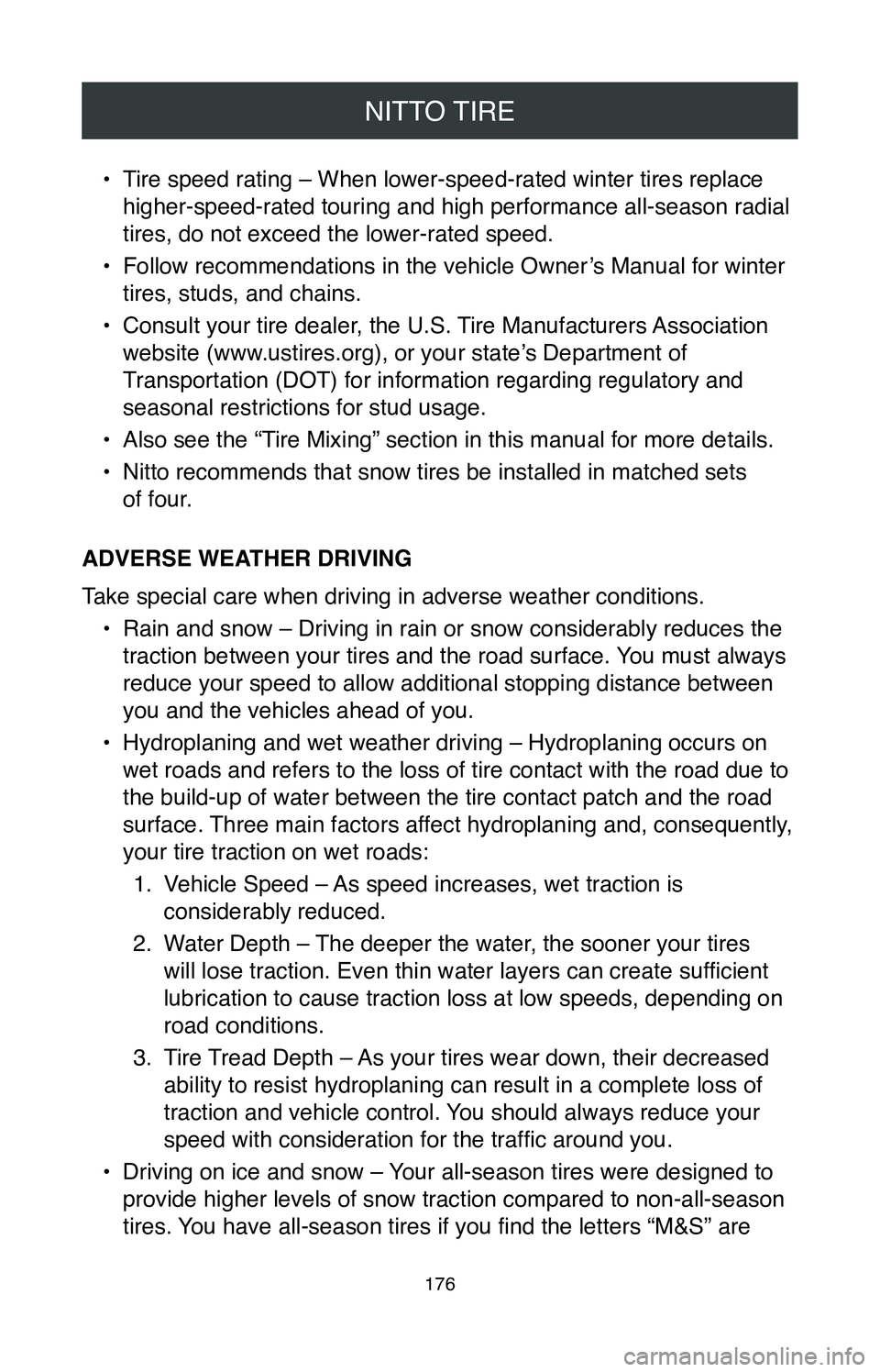
NITTO TIRE
176
• Tire speed rating – When lower-speed-rated winter tires replace
higher-speed-rated touring and high performance all-season radial
tires, do not exceed the lower-rated speed.
•
Follow recommendations in the vehicle Owner’s Manual for winter
tires, studs, and chains.
•
Consult your tire dealer, the U.S. Tire Manufacturers Association
website (www.ustires.org), or your state’s Department of
Transportation (DOT) for information regarding regulatory and
seasonal restrictions for stud usage.
•
Also see the “Tire Mixing” section in this manual for more details.
•
Nitto recommends that snow tires be installed in matched sets
of four.
ADVERSE WEATHER DRIVING
Take special care when driving in adverse weather conditions. •
Rain and snow – Driving in rain or snow considerably reduces the
traction between your tires and the road surface. You must always
reduce your speed to allow additional stopping distance between
you and the vehicles ahead of you.
•
Hydroplaning and wet weather driving – Hydroplaning occurs on
wet roads and refers to the loss of tire contact with the road due to
the build-up of water between the tire contact patch and the road
surface. Three main factors affect hydroplaning and, consequently,
your tire traction on wet roads: 1.
Vehicle Speed – As speed increases, wet traction is
considerably reduced.
2.
Water Depth – The deeper the water, the sooner your tires
will lose traction. Even thin water layers can create sufficient
lubrication to cause traction loss at low speeds, depending on
road conditions.
3.
Tire Tread Depth – As your tires wear down, their decreased
ability to resist hydroplaning can result in a complete loss of
traction and vehicle control. You should always reduce your
speed with consideration for the traffic around you.
•
Driving on ice and snow – Your all-season tires were designed to
provide higher levels of snow traction compared to non-all-season
tires. You have all-season tires if you find the letters “M&S” are
Page 194 of 260
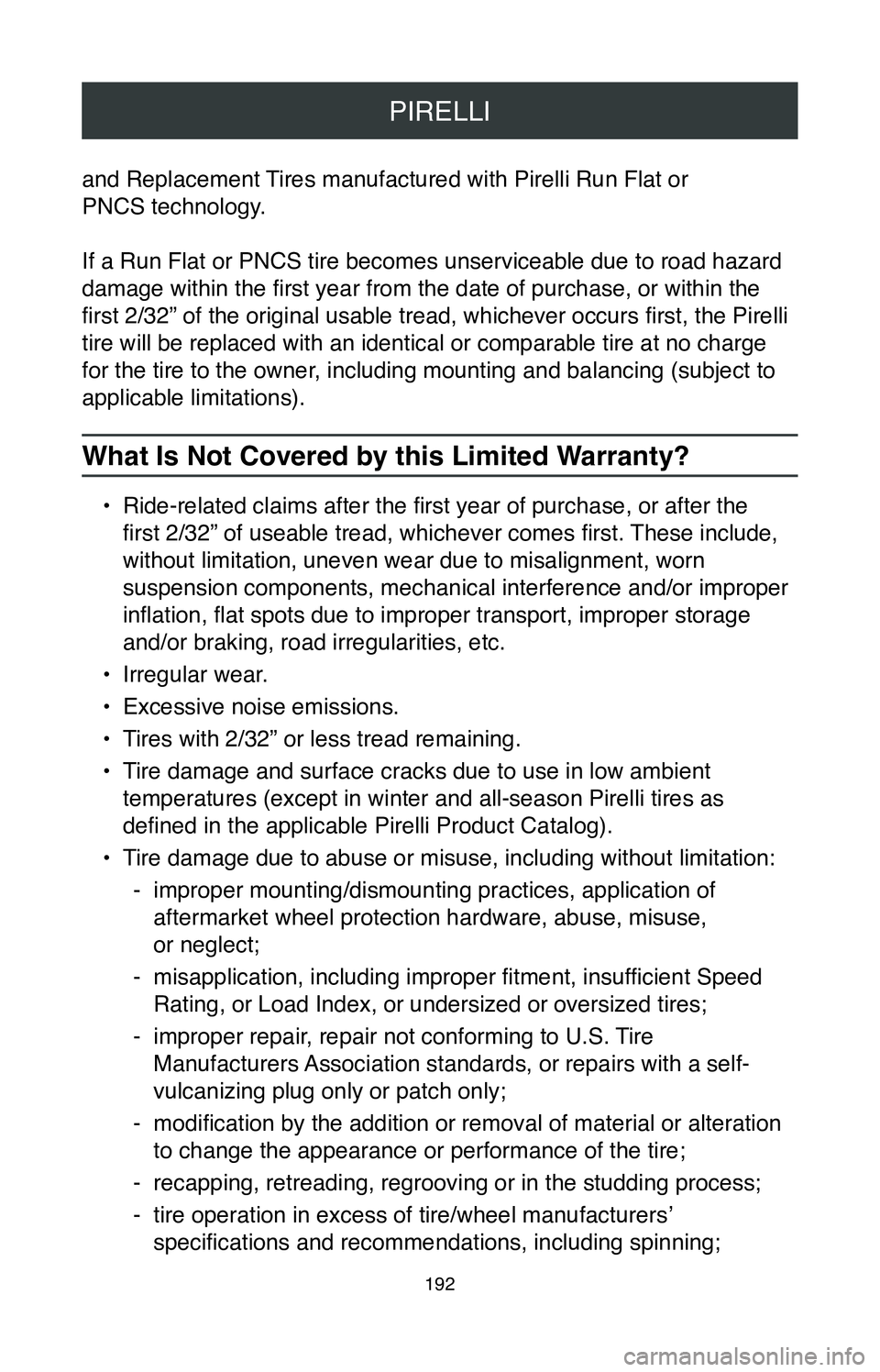
PIRELLI
192
and Replacement Tires manufactured with Pirelli Run Flat or
PNCS technology.
If a Run Flat or PNCS tire becomes unserviceable due to road hazard
damage within the first year from the date of purchase, or within the
first 2/32” of the original usable tread, whichever occurs first, the Pirelli
tire will be replaced with an identical or comparable tire at no charge \
for the tire to the owner, including mounting and balancing (subject to
applicable limitations).
What Is Not Covered by this Limited Warranty?
• Ride-related claims after the first year of purchase, or after the
first 2/32” of useable tread, whichever comes first. These include,
without limitation, uneven wear due to misalignment, worn
suspension components, mechanical interference and/or improper
inflation, flat spots due to improper transport, improper storage
and/or braking, road irregularities, etc.
•
Irregular wear.
•
Excessive noise emissions.
•
Tires with 2/32” or less tread remaining.
•
Tire damage and surface cracks due to use in low ambient
temperatures (except in winter and all-season Pirelli tires as
defined in the applicable Pirelli Product Catalog).
•
Tire damage due to abuse or misuse, including without limitation:
- improper mounting/dismounting practices, application of
aftermarket wheel protection hardware, abuse, misuse,
or neglect;
- misapplication, including improper fitment, insufficient Speed
Rating, or Load Index, or undersized or oversized tires;
-improper repair, repair not conforming to U.S. Tire
Manufacturers Association standards, or repairs with a self-
vulcanizing plug only or patch only;
- modification by the addition or removal of material or alteration
to change the appearance or performance of the tire;
-recapping, retreading, regrooving or in the studding process;
- tire operation in excess of tire/wheel manufacturers’
specifications and recommendations, including spinning;
Page 200 of 260
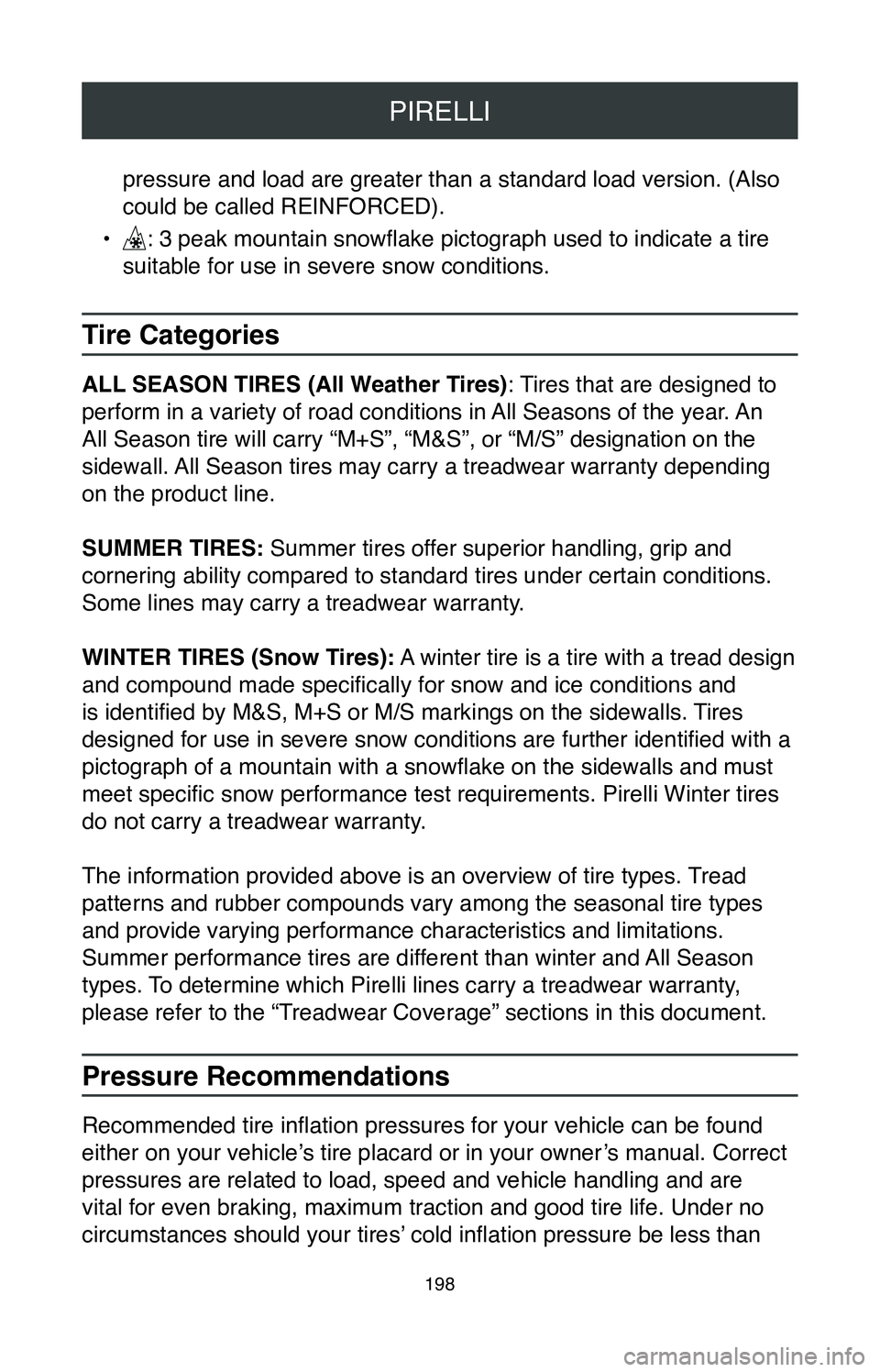
PIRELLI
198
pressure and load are greater than a standard load version. (Also
could be called REINFORCED).
•
: 3 peak mountain snowflake pictograph used to indicate a tire
suitable for use in severe snow conditions.
Tire Categories
ALL SEASON TIRES (All Weather Tires): Tires that are designed to
perform in a variety of road conditions in All Seasons of the year. An
All Season tire will carry “M+S”, “M&S”, or “M/S” desi\
gnation on the
sidewall. All Season tires may carry a treadwear warranty depending
on the product line.
SUMMER TIRES: Summer tires offer superior handling, grip and
cornering ability compared to standard tires under certain conditions.
Some lines may carry a treadwear warranty.
WINTER TIRES (Snow Tires): A winter tire is a tire with a tread design
and compound made specifically for snow and ice conditions and
is identified by M&S, M+S or M/S markings on the sidewalls. Tires
designed for use in severe snow conditions are further identified with a
pictograph of a mountain with a snowflake on the sidewalls and must
meet specific snow performance test requirements. Pirelli Winter tires
do not carry a treadwear warranty.
The information provided above is an overview of tire types. Tread
patterns and rubber compounds vary among the seasonal tire types
and provide varying performance characteristics and limitations.
Summer performance tires are different than winter and All Season
types. To determine which Pirelli lines carry a treadwear warranty,
please refer to the “Treadwear Coverage” sections in this document.
Pressure Recommendations
Recommended tire inflation pressures for your vehicle can be found
either on your vehicle’s tire placard or in your owner’s manual. Correct
pressures are related to load, speed and vehicle handling and are
vital for even braking, maximum traction and good tire life. Under no
circumstances should your tires’ cold inflation pressure be less than
Page 201 of 260
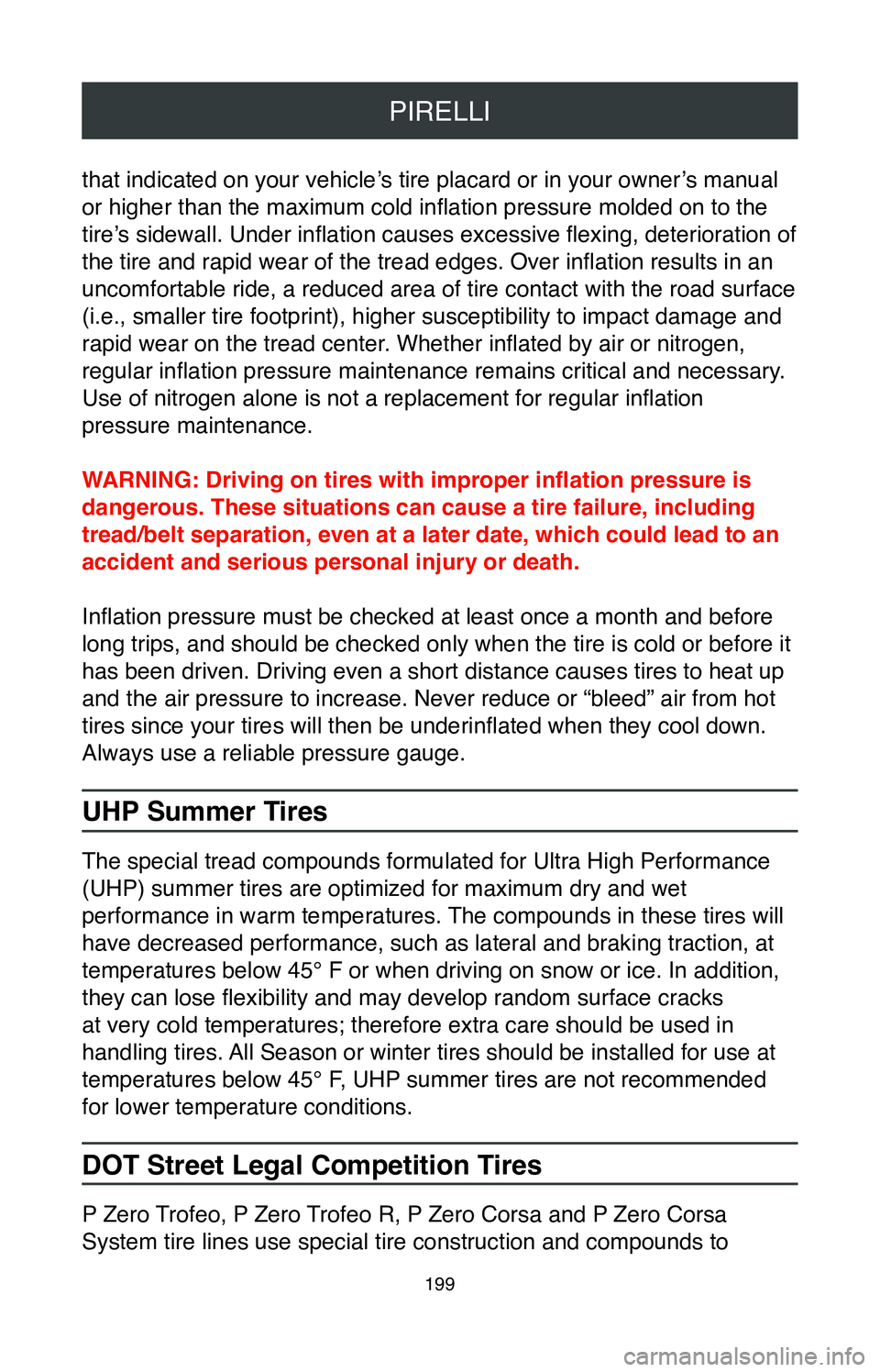
PIRELLI
199
that indicated on your vehicle’s tire placard or in your owner’s manual
or higher than the maximum cold inflation pressure molded on to the
tire’s sidewall. Under inflation causes excessive flexing, deterioration of
the tire and rapid wear of the tread edges. Over inflation results in an
uncomfortable ride, a reduced area of tire contact with the road surface\
(i.e., smaller tire footprint), higher susceptibility to impact damage and
rapid wear on the tread center. Whether inflated by air or nitrogen,
regular inflation pressure maintenance remains critical and necessary.
Use of nitrogen alone is not a replacement for regular inflation
pressure maintenance.
WARNING: Driving on tires with improper inflation pressure is
dangerous. These situations can cause a tire failure, including
tread/belt separation, even at a later date, which could lead to an
accident and serious personal injury or death.
Inflation pressure must be checked at least once a month and before
long trips, and should be checked only when the tire is cold or before i\
t
has been driven. Driving even a short distance causes tires to heat up
and the air pressure to increase. Never reduce or “bleed” air from\
hot
tires since your tires will then be underinflated when they cool down.
Always use a reliable pressure gauge.
UHP Summer Tires
The special tread compounds formulated for Ultra High Performance
(UHP) summer tires are optimized for maximum dry and wet
performance in warm temperatures. The compounds in these tires will
have decreased performance, such as lateral and braking traction, at
temperatures below 45° F or when driving on snow or ice. In addition,\
they can lose flexibility and may develop random surface cracks
at very cold temperatures; therefore extra care should be used in
handling tires. All Season or winter tires should be installed for use at
temperatures below 45° F, UHP summer tires are not recommended
for lower temperature conditions.
DOT Street Legal Competition Tires
P Zero Trofeo, P Zero Trofeo R, P Zero Corsa and P Zero Corsa
System tire lines use special tire construction and compounds to
Page 202 of 260
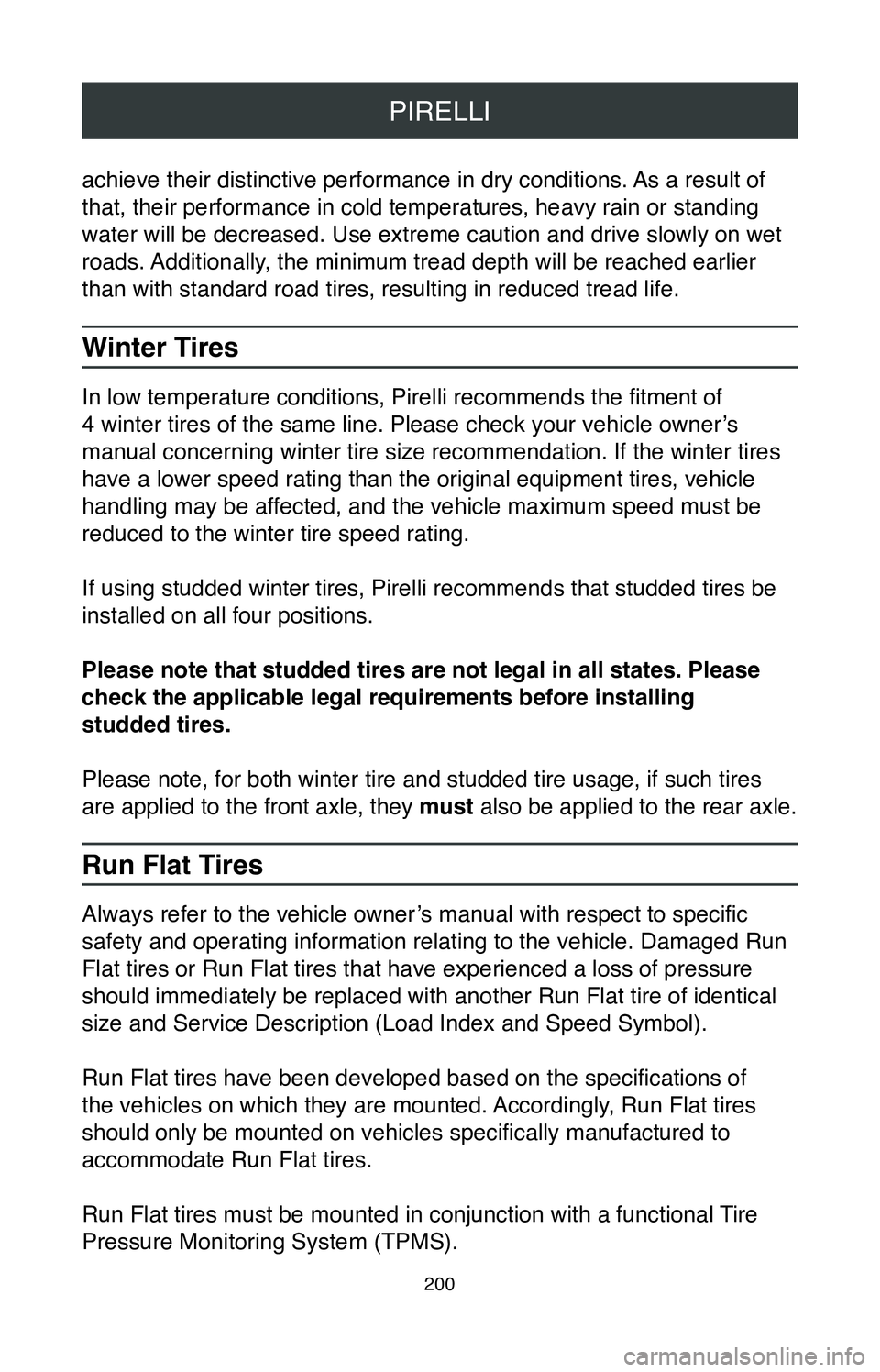
PIRELLI
200
achieve their distinctive performance in dry conditions. As a result of
that, their performance in cold temperatures, heavy rain or standing
water will be decreased. Use extreme caution and drive slowly on wet
roads. Additionally, the minimum tread depth will be reached earlier
than with standard road tires, resulting in reduced tread life.
Winter Tires
In low temperature conditions, Pirelli recommends the fitment of
4 winter tires of the same line. Please check your vehicle owner’s
manual concerning winter tire size recommendation. If the winter tires
have a lower speed rating than the original equipment tires, vehicle
handling may be affected, and the vehicle maximum speed must be
reduced to the winter tire speed rating.
If using studded winter tires, Pirelli recommends that studded tires be \
installed on all four positions.
Please note that studded tires are not legal in all states. Please
check the applicable legal requirements before installing
studded tires.
Please note, for both winter tire and studded tire usage, if such tires \
are applied to the front axle, they must also be applied to the rear axle.
Run Flat Tires
Always refer to the vehicle owner’s manual with respect to specific
safety and operating information relating to the vehicle. Damaged Run
Flat tires or Run Flat tires that have experienced a loss of pressure
should immediately be replaced with another Run Flat tire of identical
size and Service Description (Load Index and Speed Symbol).
Run Flat tires have been developed based on the specifications of
the vehicles on which they are mounted. Accordingly, Run Flat tires
should only be mounted on vehicles specifically manufactured to
accommodate Run Flat tires.
Run Flat tires must be mounted in conjunction with a functional Tire
Pressure Monitoring System (TPMS).
Page 227 of 260
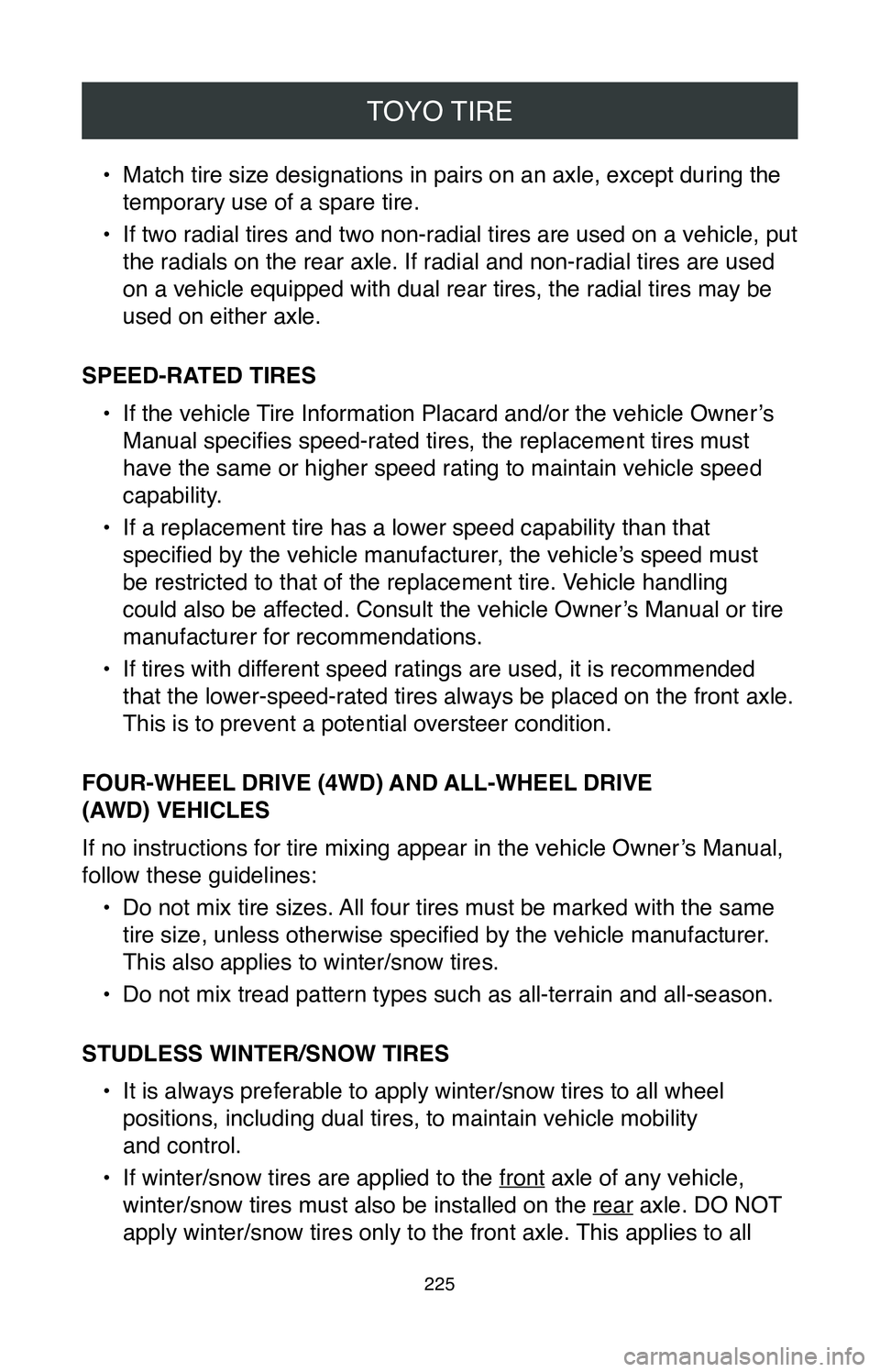
TOYO TIRE
225
• Match tire size designations in pairs on an axle, except during the
temporary use of a spare tire.
•
If two radial tires and two non-radial tires are used on a vehicle, put
the radials on the rear axle. If radial and non-radial tires are used
on a vehicle equipped with dual rear tires, the radial tires may be
used on either axle.
SPEED-RATED TIRES •
If the vehicle Tire Information Placard and/or the vehicle Owner’s
Manual specifies speed-rated tires, the replacement tires must
have the same or higher speed rating to maintain vehicle speed
capability.
•
If a replacement tire has a lower speed capability than that
specified by the vehicle manufacturer, the vehicle’s speed must
be restricted to that of the replacement tire. Vehicle handling
could also be affected. Consult the vehicle Owner’s Manual or tire
manufacturer for recommendations.
•
If tires with different speed ratings are used, it is recommended
that the lower-speed-rated tires always be placed on the front axle.
This is to prevent a potential oversteer condition.
FOUR-WHEEL DRIVE (4WD) AND ALL-WHEEL DRIVE
(AWD) VEHICLES
If no instructions for tire mixing appear in the vehicle Owner’s Manual,
follow these guidelines: •
Do not mix tire sizes. All four tires must be marked with the same
tire size, unless otherwise specified by the vehicle manufacturer .
This also applies to winter/snow tires.
•
Do not mix tread pattern types such as all-terrain and all-season.
STUDLESS WINTER/SNOW TIRES •
It is always preferable to apply winter/snow tires to all wheel
positions, including dual tires, to maintain vehicle mobility
and control.
•
If winter/snow tires are applied to the front axle of any vehicle,
winter/snow tires must also be installed on the rear axle. DO NOT
apply winter/snow tires only to the front axle. This applies to all
Page 228 of 260
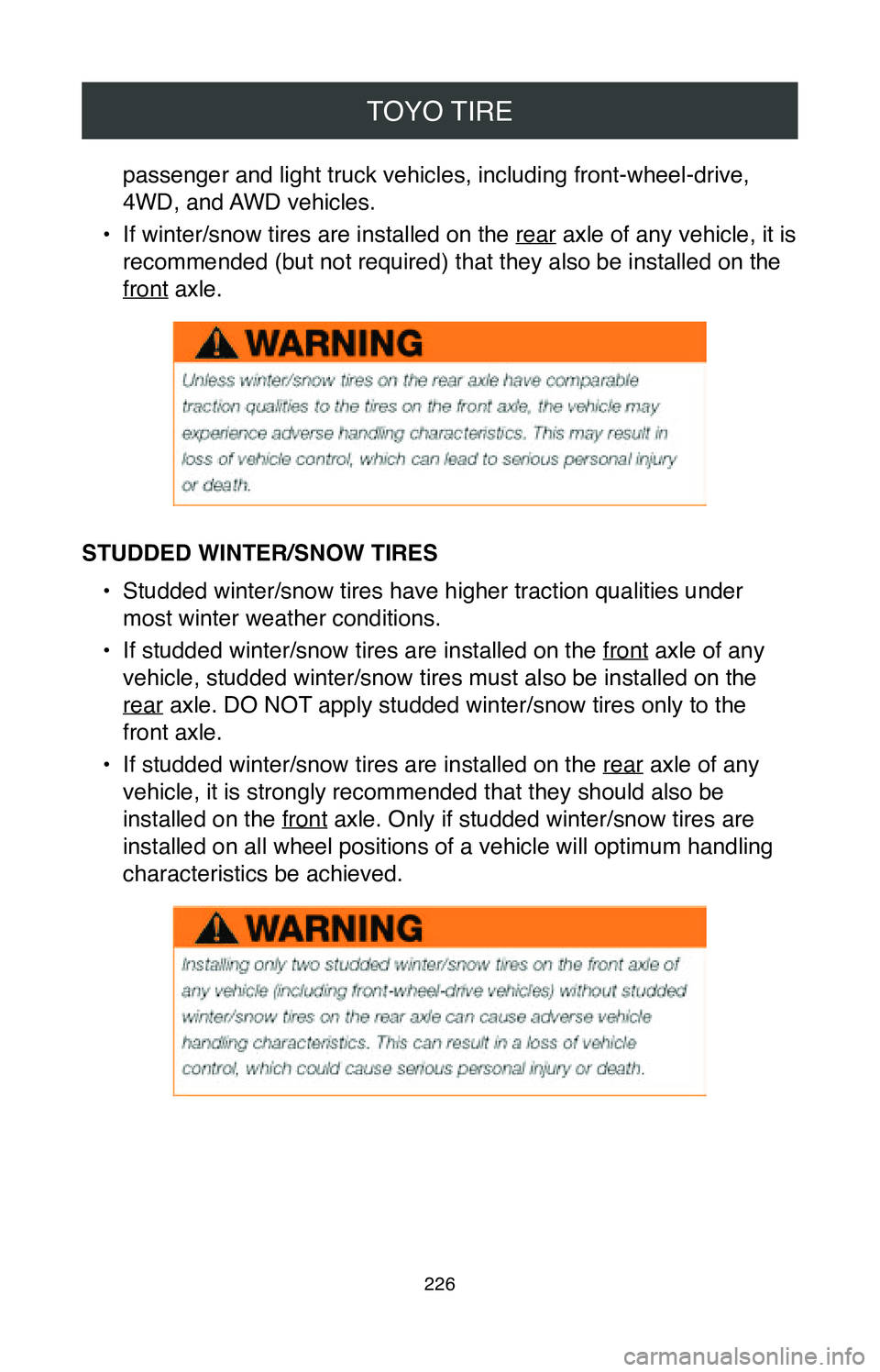
TOYO TIRE
226
passenger and light truck vehicles, including front-wheel-drive,
4WD, and AWD vehicles.
•
If winter/snow tires are installed on the rear axle of any vehicle, it is
recommended (but not required) that they also be installed on the
front axle.
STUDDED WINTER/SNOW TIRES
•
Studded winter/snow tires have higher traction qualities under
most winter weather conditions.
•
If studded winter/snow tires are installed on the front axle of any
vehicle, studded winter/snow tires must also be installed on the
rear axle. DO NOT apply studded winter/snow tires only to the
front axle.
•
If studded winter/snow tires are installed on the rear axle of any
vehicle, it is strongly recommended that they should also be
installed on the front axle. Only if studded winter/snow tires are
installed on all wheel positions of a vehicle will optimum handling
characteristics be achieved.
Page 236 of 260
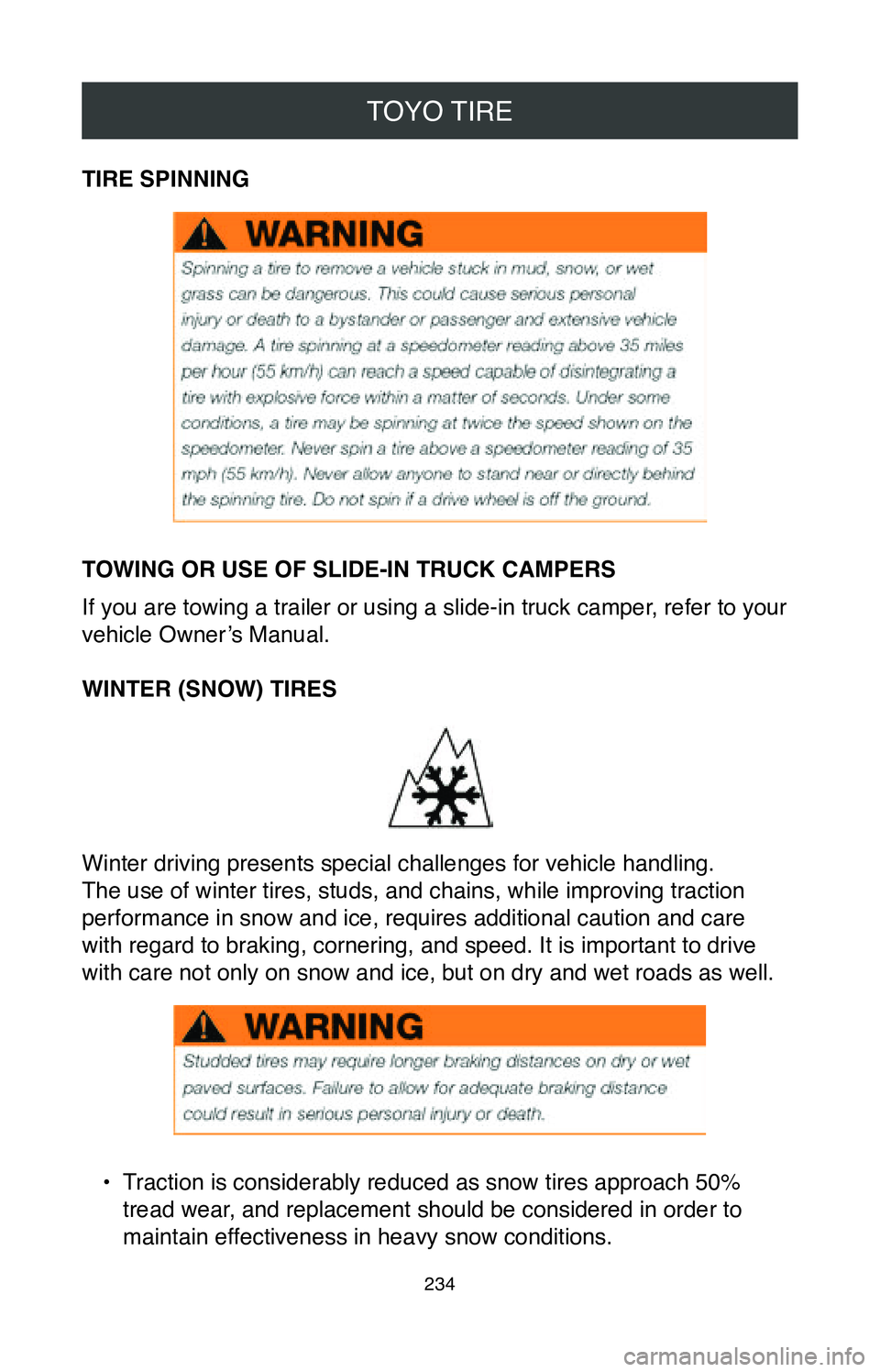
TOYO TIRE
234
TIRE SPINNING
TOWING OR USE OF SLIDE-IN TRUCK CAMPERS
If you are towing a trailer or using a slide-in truck camper, refer to your
vehicle Owner’s Manual.
WINTER (SNOW) TIRES
Winter driving presents special challenges for vehicle handling.
The use of winter tires, studs, and chains, while improving traction
performance in snow and ice, requires additional caution and care
with regard to braking, cornering, and speed. It is important to drive
with care not only on snow and ice, but on dry and wet roads as well.
• Traction is considerably reduced as snow tires approach 50%
tread wear, and replacement should be considered in order to
maintain effectiveness in heavy snow conditions.